Contents
- Biological Diversity and Disparity
- Evolution
- Phylogenies
- Hox Genes
- Ediacaran (635-541 MYA)
- Cambrian Explosion (541 MYA)
- Proof of the Cambrian Explosion
- Cause of the Cambrian Explosion
- Complex Systems
- Radioactive Isotopes
- Stable Isotopes
- Ordovician (489-445 MYA)
- End-Ordovician Extinction
- Silurian (445-423 MYA)
- Devonian (419-358 MYA)
- End-Devonian Extinction
- Carboniferous (358-298 MYA)
- Permian (298-252 MYA)
- P-T Extinction
- Triassic (252-201 MYA)
- End-Triassic Extinction
- Jurassic (201-145 MYA)
- Cretaceous (145-65 MYA)
- K-T Extinction
Generation of Biological Diversity
- Model System
- Adaptive Radiation
- Non-Adaptive Radiation
- Conservation
- Adaptive and Non-Adaptive Radiation
- Ecogeographic rules
- Wallace's Line
- Out-Of-India Hypothesis
- The Great American Interchange
- Sexual Selection
Module 3: Big Questions
- Evolution of beauty
- The scientific method
- Are there limits on what evolution can achieve?
- Are we alone in the universe?
- Morality, human personality, and emotion
Paleozoic Era
Earth originated 4.5 BYA.
Life originated 4 BYA.
Complex life appeared 541 MYA.
Complex life is multicellular, mobile organisms that interact with each other and their environment.
Question: Given the apparent productivity of complex life on Earth, why did it take 3 billion years after the earliest evidence of life for complex, diverse life forms to occur?
Biological Diversity and Disparity
Diversity is the number of different kinds of organisms. Disparity is the range of different kinds of organisms. Lower taxonomic levels like "genera" usually represents diversity and higher taxonomic levels like "classes" or phyla" usually represents disparity.
Disparity has only happened once, during the Cambrian Explosion. Diversification events have happened multiple times.
The long-term trend in biological diversity is net positive, but there have been many mass extinctions. This chart by Sepkoski (1981) shows the change in diversity over geological time in terms of number of marine families.

Evolution
Evolution is the change in gene frequencies in a population over time. There are 4 mechanisms of evolution: mutation, migration, drift, and selection. Mutation is the only mechanism that actually introduces novelty.
For natural selection to occur, we make a few assumptions:
- Traits are heritable
- Traits impact fitness
- Traits that positively impact fitness are selected for, and traits that negatively impact fitness are selected against
Speciation happens when there is reduced gene flow between populations, and they become reproductively isolated. Species are usually defined as the largest group of organisms in which two individuals can produce fertile offspring.
Phylogenies
Diversity can be explained by lines of descent. Cladograms are based on shared traits, while phylogenies are cladograms that are specifically based on shared genes. Note that some organisms that are closely related are dissimilar, and vice versa. Relatedness is based on the most recent common ancestor (MRCA). Recency is measured in genealogical time, not calendar time.
A monophyletic group (single tree), or a clade, consists of a MRCA and all of its descendants. A paraphyletic group consists of a MRCA, but not all of its descendants.
The crown group is the MRCA of all living members of a clade, and all of its descendents. It is a type of monophyletic group that must have living descendants by definition. The pan group is the crown group and all organisms that share an ancestor with the crown more recently than any other living organism. The stem group is the pan group minus the crown group.
On the vertebrate phylogeny, agnatha, osteichthyes, and reptilia are paraphyletic groups. The rest are monophyletic groups.

On the bird and crocodile phylogeny, pterosauria and dinosauria are sister groups. Crown group Aves is the Neornithes. Pan group Aves is all animals more closely related to Neornithes than to Crocodylia, which includes archeopteryx, dinosauria, and pterosauria.


Phylogenies can tell us about when a trait evolved. For example, we can infer that the MRCA of all animals had a nervous system because all animals except sponges have a nervous system.

Genomic data is unclear about whether ctenophores or sponges are the sister group to all other animals.
Hox Genes
There is a DNA binding protein which regulates gene expression. Thus, genes are turned on when they are needed.
There is a 180 base-pair sequence present in most homeotic genes which regulate development. This sequence was called the homeodomain, homeobox, or hox genes. It was once assumed that the degree of disparity should be proportional to the degree of genotypic similarity. However, hox genes are able to produce large changes in morphology with small changes in genotype.
Similarities in the homeobox sequence suggest that all hox genes arose from a single gene that was duplicated multiple times and allowed to perform new tasks.

Hox genes are part of a set of regulatory genes called the developmental genetic toolkit. The toolkit is highly conserved across animals, and it is responsible for the development of body plans. It turns out that complex traits like eyes didn't evolve multiple times independently, but rather evolved once and were lost in some lineages.
One example is the eyeless gene (Pax-6, smalleye) which seems to be a master gene for eye development. Inserting smalleye from mice into fruit flies causes them to develop normal fruit fly eyes, not mice eyes.
Ediacaran (635-541 MYA)
Before the Cambrian explosion, no fossils of large organisms were thought to have existed. This is why the period after the Cambrian explosion was called the Phanerozoic period ("visible animal"). The discovery of Charnia masoni (600 MYA) in 1957 changed this view.
More Ediacarian fossils were found, including dickinsonia, kimberella, spriggina, and Ikaria wariaootia.
Dickinsonia was important because it showed that Ediacaran organisms were animals. All animals today have cholesteroids, and cholesteroids were found in dickinsonia fossils but not in the surrounding sediment. Furthermore, the superficially bilateral symmetry of dickinsonia and other Ediacaran organisms suggested that they were bilaterians.
Cambrian Explosion (541 MYA)
The Cambrian Explosion was the first diversification event, and it also represented the onset of animal disparity. It led to to the appearance of most animal phyla (37).

It is defined by the first appearance of the trace fossil Treptichnus pedum.
Fossils that appeared in the Cambrian Explosion include trilobites and anomalocaris ("anomalous shrimp"). They had complex features like segmented bodies, compound eyes, exoskeletons, and appendages.
Proof of the Cambrian Explosion
The existence of the Cambrian explosion is supported by:
- The reading of the fossil record
- Molecular clock analysis by Erwin et al. (2011)
First, the fossil record shows a rapid increase in disparity during the Cambrian explosion. However, the fossil record is imperfect. For fossilization to happen, the following needs to occur:
- The fossil is buried in quick-moving sediment
- The fossil is not destroyed by geological processes
- The fossil is found after millions of years
This means that the animals that are fossilized could be biased towards those that lived in environments with quick-moving sediment, had hard parts, and were large enough to be seen.
The fossil record is supported by the molecular clock. Erwin et al. estimated divergence times of animal phyla and found that most phylum-level crown-group divergences occurred during the end of the Ediacaran and the Cambrian.
The molecular clock is a method that uses the mutation rate of genes to deduce the time when two organisms shared a common ancestor. We know that , where is time since divergence, is the number of genetic differences, and is the rate of genetic change. Finding the rate requires calibration with known divergence times from the fossil record.

Cause of the Cambrian Explosion
There are three things that need to be explained:
- Why it was the only increase in animal disparity
- Why it happened 541 MYA
- Why it was so rapid (10 MY)
We do know that for the Cambrian explosion to occur, it was necessary to have an environment that can support animal life and to have the genetics machinery that can produce wide disparity. However, these are not sufficient conditions, and none of the environmental explanations can create a causal link. It is possible that the onset of disparity only happened once because evolution was able to quickly find all ecologically viable morphologies.
Here are more detailed hypotheses from Marshall 2006:
-
Increase in O2
Limited O2 could have limited animal evolution, since it is necessary for collagen synthesis. It is generally agreed that animals could not have evolved if O2 was <1% present (Towe limit). The problem with this theory is that substantial O2 had already exceeded the Towe limit long before the Cambrian explosion. While O2 is necessary for the increase in diversity, it is not a sufficient condition.

-
Snowball Earth
The Earth experienced deep freezes during the Cryogenian period and Ediacaran period, and Ediacaran organisms appeared after the last of these events, the Gaskier Glaciers. The problem is that the last deep freeze was much earlier than the Cambrian explosion, so the causal link is unclear.
-
C isotope anomaly
There was a large negative carbon isotope anomoly that has been assumed to cause the Ediacaran mass extinction and the Cambrian diversification event. It is true that isotope anomalies and mass extinctions could lead to diversification, such as mammal diversification after the KT boundary. However, this is not a fair comparison since the KT event involved the replacement of a few clades by a sister clade. The link between the C isotope anomaly and the Cambrian explosion is not clear.
-
Developmental genetic toolkit
Hox genes regulate other genes that control growth, development, and patterning. Current bilaterians possess a set of 7 common, interchangeable Hox genes, so the MRCA of all bilaterians must have had these genes. Since molecular clocks place the earliest bilaterian long before the Cambrian, we know that Cambrian animals must have possessed Hox genes.
A relatively small change in Hox genes can lead to a large change in morphology, so this this is both necessary and sufficient for the large increase in disparity during the Cambrian explosion. The problem is that Hox genes existed for over 100 million years before the Cambrian explosion, so it does not explain why the Cambrian explosion didn't happen sooner.
-
Adaptive radiation
The first evidence of predation occurred near the end of the Ediacaran, perhaps leading to biomineralized shells and hard skeletons. This could have been facilitated by oxygenation of the atmosphere, leading to the establishment of bottom-up food webs. While this arms race is a necessary and sufficient condition for the increase in diversity, it does not explain the rest of the Cambrian explosion.
Mesozoic Era
Complex Systems
Complex systems have many interacting components, and they exhibit surprising emergent properties.
The Earth is a complex system made up of the atmosphere, biosphere, hydrosphere, and lithosphere. The biosphere consists of autotrophs (producers) and heterotrophs (consumers).
The global carbon cycle is a complex system. The carbon cycle is strongly impacted by photosynthesis and cellular respiration. Photosynthesis is dictated by this equation: . Cellular respiration is the reverse.
The black arrows represent CO2 fluxes and the blue arrows represente O2 fluxes.

Effects of Paleozoic life on the Earth system:
- Expansion of land plants led to decline of atmospheric CO2
- Expansion of land plants led to increase in atomospheric O2
- Phosphorus inputs led to ocean fertilization and anoxia (low oxygen)
Effects of increase in atmospheric O2:
- Insect gigantism like meganeura
- Large predatory fish like dunkleosteus
- Increased wildlife
Radioactive Isotopes
There are two types of isotopes: radioactive and stable. Radioactive isotopes include U248, which decays to Pb206, as well as C14.
Radioactive isotopes experience nuclear decay at an exponential rate, expressed in terms of half-life.
Different isotopes have different half-lives. C14 is useful to about 60,000 years ago. U238 is useful to determine the ages of rocks that formed with the early Earth. This is mainly done with zircon crystals that have U238 but strongly reject Pb when formed.
| Isotope | Half-life |
|---|---|
| 5,730 Y | |
| 4.5 BY |
Stable Isotopes
Stable isotopes include C12-13, O16-18, H1, H2 (deuterium), H3.
Two natural processes fractionate against certain stable isotopes:
- Evaporation (H2O) fractionates against deuterium, since it is heavier and needs more energy. In warmer temperatures, water with deuterium isotopes are more likely to evaporate than in cooler temperatures.
- Photosynthesis (C) fractionates against C13, since it is heavier and needs more energy. Plants prefer to take in C12. Thus, you expect from a biological source to be less than that from a geological source.
The abundance of stable isotopes is expressed relative to a standard. For C13, the standard is Pee Dee belemnite.
is equal to when the sample and the standard are equal, less than when the sample is relatively depleted in carbon-13, and the opposite when it is greater than .
Because decays, fossil fuels tend to be depleted in . Thus, the burning of fossil fuels leads to a decrease in in the atmosphere. This is known as the Suess effect, and it is evidence that the increase in CO2 is actually due to fossil fuel combustion.

Ordovician (489-445 MYA)
During the Cambrian, there was only a microbial crust (fungi, cyanobacteria) on land. During the Ordovician, marine diversity increased in mollusks and arthropods.
End-Ordovician Extinction
Wiped out 60% of marine genera.
Volcanic activity deposits silicate minerals on the ground that suck CO2 from the atmosphere, reducing the greenhouse effect and leading to cooling. As ice sheets expand, silicate minerals are covered, leading CO2 to build up again. This creates a negative feedback loop. The silicate-weathering hypothesis states that this contraction and expansion of sea levels caused the extinctions.
We know life decreased when delta 13C increases, because biological processes factionate against 13C.
Silurian (445-423 MYA)
Sea levels are high and oceans are warm.
- Bony and jawed fish appear
- Large arthropods in shallow seas (eurypterids)
- Coral reefs form
Vascular plants (like cooksonia) and small arthropods appeared on land. The first air-breathing animal appeared (Pneumodesmus newmani). Nevertheless, life on land did not really diversify until the Devonian.
Devonian (419-358 MYA)
Known as the "Age of Fish"
- Actinopterygii ("ray-finned") and lobe-finned fishes (coelacanth, lungfish) appeared
- Placoderms ("armored fish") (dunkleosteus) diversified and then became extinct in the end
- Cartilagenous fishes include sharks, skates, and rays
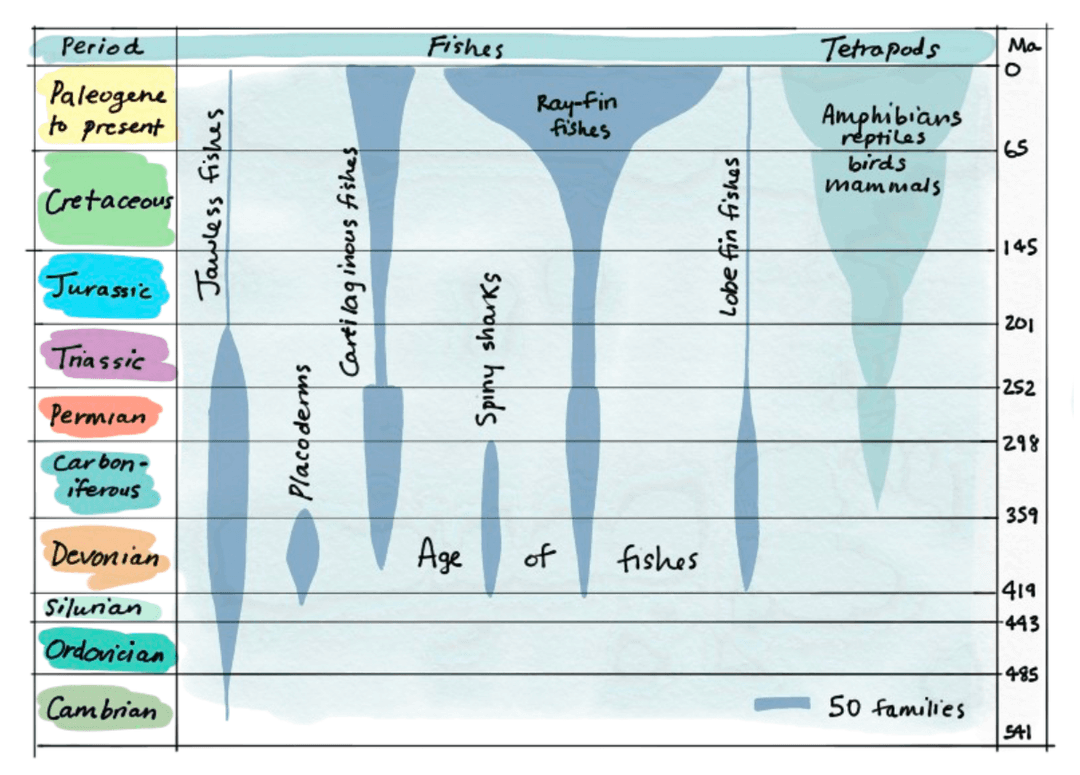
Life on land diversified
- Tetrapods (ichthyostega, tiktaalik, eusthenopteron) began adapting to land
- The first forests appeared (archaeopteris), which provided habitat for terrestrial arthropods
- The first insects appeared
End-Devonian Extinction
Poorly understood, could be a series of smaller extinction events.
It is hypothesized that increased terrestrial life led to increased nutrient runoff in the ocean. Plants grow but then decay. The microbes consume the decaying plants in a aerobic process, taking oxygen from the water. TLDR: Phosphorus inputs led to eutrophication, leading to ocean fertlization and anoxia.
Carboniferous (358-298 MYA)
Trees with bark appeared at this time. Bark was made of lignin, which could not be digested by anything. This caused wood to accumulate in the swamp, moving C from the atmosphere to the soil. Many coal beds also formed during this time, leading to the name Carboniferous ("coal-bearing").
Through photosynthesis, the trees took CO2 out of the atmosphere and brought more O2 into the atmosphere. When they died, the carbon in their bodies was buried and sequestered in the soil. Eventually, a mechanism to consume lignin in an aerobic process evolved, causing the downturn in the Carboniferous oxygen spike.

Some insects rely on a diffusion system to circulate oxygen in their body. Because there was a larger concentration of oxygen, a larger body size could be supported, known as gigantism. Additionally, more fires happened.
Permian (298-252 MYA)
Amniotes radiated into early mammals, birds, and reptiles. This brought large carnivores (dimetrodon) and herbivores (diadectes) on land.

Dimetrodon
- In the clade synapsida
- Has reptilian (gait, skin) and mammalian (teeth, skull) characteristics
- Sail may be for thermal regulation or sexual selection
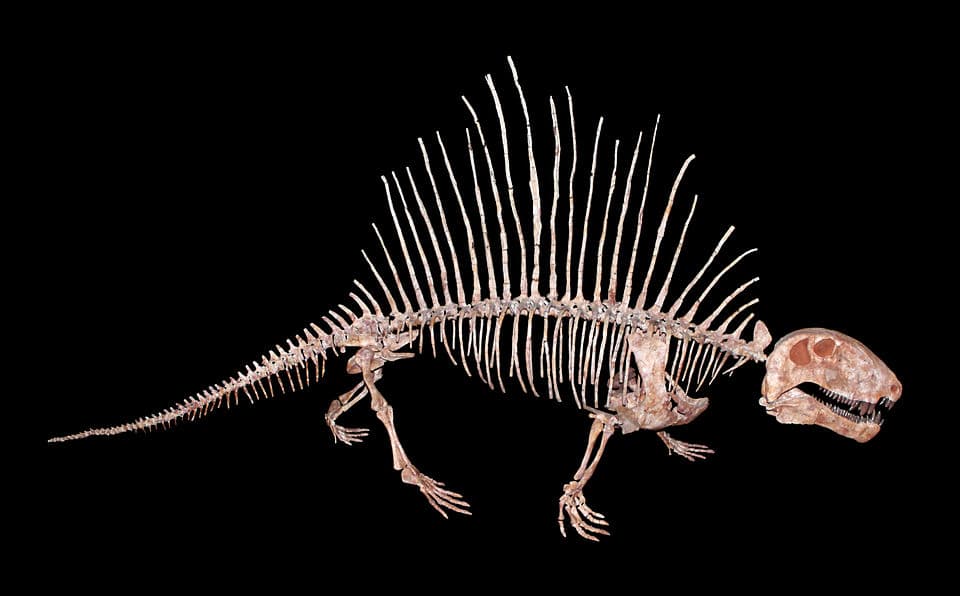
Diadectes
- Tetrapod with both reptilian (teeth) and amphibian (Otis notches) characteristics
- Otis notches distinguishes amniotes from later amphibians

P-T Extinction
Largest mass extinction, also known as "The Great Dying." Wiped out 95% of marine species and 75% of terrestrial vertebrate species. Half of all families and 8 in 10 species.
Before end-Permian, there were corals, bryozoans, crinods, and fishes. Afterward, reefs disappeared, Clairia becomes the dominant bivalve, and some ammonoids survived. Lystrasaurus became the dominant terrestrial vertebrate.
Burgess et al (2014) used Zircon crystals to estimate the extinction interval. Zircon is a mineral in volcanic rocks that contains the radioactive isotope U-238, which decays in Pb-206. At its formation, zircon strongly rejects Pb, so any Pb found in the crystal must have been produced by radioactive decay. By measuring the ratio of U to Pb, we can estimate the age of the crystal.
By taking the dates for the ash beds above and below the P-T boundary, they found that the extinction interval was roughly 0.061 +/- 0.048 MY. This was consistent with findings in Penglaitan, Guangxi, which dated 0.031 +/- 0.031 MY interval.
The favored explanation for the extinction is volcanic activity in the Siberian traps. Large amounts of CO2 and SO2 may have been released into the atmosphere, causing climate change (greenhouse gasses), ocean warming, and ocean acidification (when dissolved into seawater).
Circumstantially, sea surface temperature increased by 10 degrees C over the extinction interval. We know that oceans can warm in response to volcanic activity, such as in El Chichón and Pinatubo.
Triassic (252-201 MYA)
The supercontinent Pangea had dry interiors with more extreme temperatures. The widespread deserts were ideal for reptiles.
End-Permian extinction cleared the slate for therapsids and archosaurs. Therapsids are stem mammals that descended from synapsids ("pelycosaurs") like Dimetrodon. Right after the end-Permian extinction, lystrasaurus became the dominant terrestrial vertebrate.

Archosaurs are crown crocodiles and birds, and include therapods like coelophysis.
Marine reptiles like plesiosaurs and ichthyosaurs also thrived.
Tetrapods (stem amphibians) grew larger, like the temnospondyli.
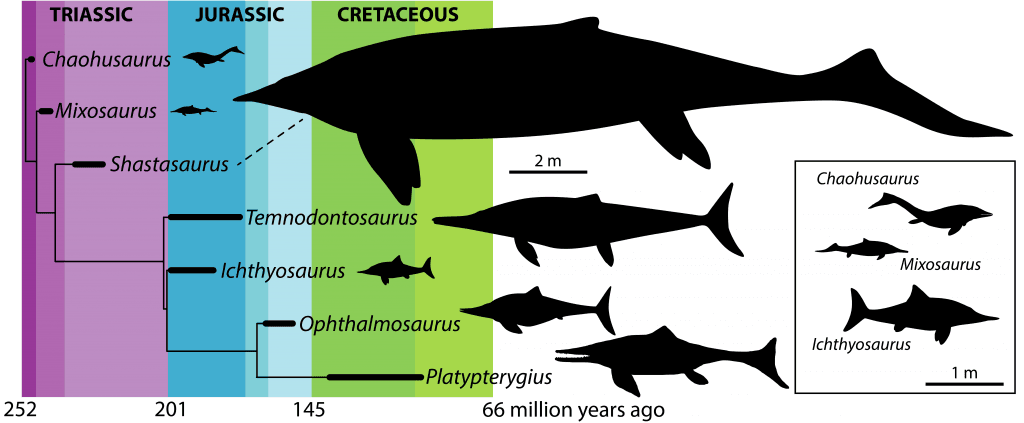
End-Triassic Extinction
Many groups of amphibians and reptiles were replaced by dinosaurs. Most of the impact was on marine animals.
It is unclear what caused the extinction. Some theories include:
- Volcanic outgassing of CO2 and SO2
- Progressive drying (aridification)
- Extraterrestrial impact
- Sudden release of methane hydrates from the sea floor
Many 4 different patterns in diversity have been observed: stepwise decline, persistence, sudden extinction, and insufficient data.
A negative carbon isotope spike preceded the extinction, which did not recover. This signaled a disruption to the carbon cycle.

Jurassic (201-145 MYA)
The continents separate into Laurasia (North) and Gondwana (South), and more humid climates like rain forests appeared.
Known as the "Age of Reptiles"
- Land fauna became dominated by dinosaurs
- The first birds evolved from therapods
- The first lizards appeared
- The first placental mammals evolved
- Pterosaurs (dimorphodon, dawndraco, quetzalcoatalus) were the dominant flying vertebrates
Transistional forms of feathers demonstrate that modern birds are unambiguously theropods.
Why did feathers evolve?
- Flight for survival
- Thermoregulation, like down feathers
- Signaling
It has been questioned whether large pterosaurs could actually fly. They most likely could lift off using a quadrupedal launch.
Saurischians are lizard-hipped dinosaurs.
- Therapods are bipedial carnivores like coelophysis, allosaurus, tyrannosaurus, and birds
- Sauropods are quadrapedal herbivores like brachiosaurus, diplodocus, titanosaurus
Ornithischians are bird-hipped and mainly herbivorous.
- Ceropsians like triceratops
- Pachycephalosaurus
- Armoured dinosaurs like stegosaurs and ankylosaurs
- Ornithopods like parasauropholous
Cretaceous (145-65 MYA)
- Dinosaurs dominated on land, and there were abundant marine reptiles.
- Divergence between placental (elephants, cats, humans) and marsupial mammals (kangaroos, koalas) occured
- Insects diversified (butterflies, moths, ants, termites)
- Angiosperms (flowering plants) increased
K-T Extinction
The K-T extinction caused the extinction of the all non-avian dinosaurs. By removing large carnivores, mammals were able to diversify.
The extinction was caused by an extraterrestrial impact near the Yucatan peninsula. The meteor, around 10 km in diameter, injected an enormous amount of material into the atmosphere that absorbed sunlight. As a result, photosynthesis stopped, and the food chain collapsed. Animals dependent on phytoplankton, as well as animals at higher levels on the food chain, were greatly affected. However, while plants died, seeds survived.
Alvarez et al discovered an anomalously large concentration of iridium within the K-T boundary sediment in Italy and Denmark. The chemistry of that layer was also distinct from the layers around it in that it contained pyrite and sulfides, but not calcium carbonate.
Here are a few models that were rejected:
- The earth could not have been the source of iridium. Suppose that terrestrial material was concentrated. Then if the concentration of iridium was x times higher than normal, then we would expect other elements to also be x times higher. But this was not the case in the boundary layer.
- While a supernova could have been a source of iridium, no other evidence of a supernova (like plutonium-244) was found. Additionally, the ratio of Ir191/Ir193 very closely matches that of chondritic meteorites.
- While it is not possible to dismiss that meteoritic material had slowly accumulated, no known mechanism for this is known.
Finally, an impact crater was discovered on the Yucatan peninsula, called the Chicxulub crater. Based on radioactive decay of Ar40 to Ar39, the impact corresponded to the KT boundary (+/- 32,000 years). Additionally, spherules of glass from the impact where found preserved in fish gulls.
Philosophically, the meteor impact hypothesis is a great example of the scientific method. The meteor impact hypothesis was a risky prediction; if it wasn't true, it should be easy to disprove. We considered many models but had to reject them because they didn't match the data. Only the meteor hypothesis was failed to be rejected.
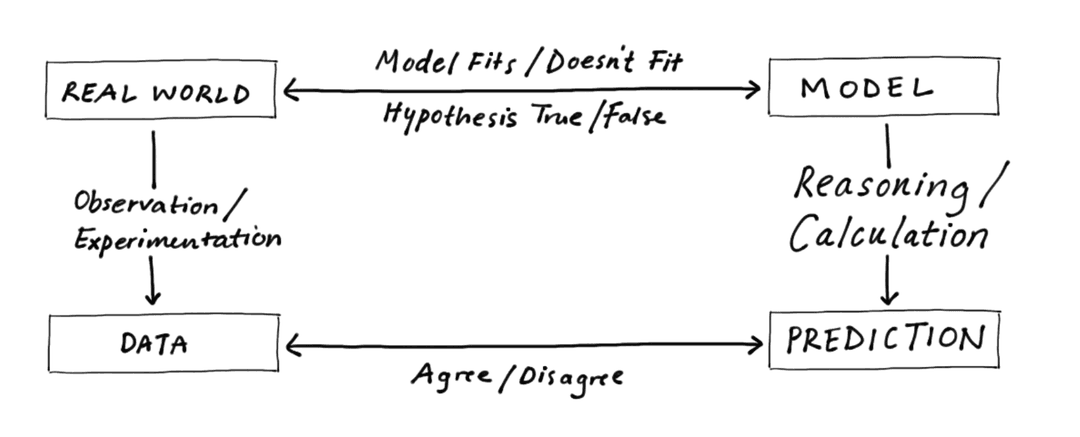
Timeline
| Period | Notes |
|---|---|
| Cambrian | |
| Ordovician | |
| Silurian | High sea levels, eurypterids |
| Devonian | "Age of Fish," tetrapods |
| Carboniferous | Oxygen spike |
| Permian | Amniotes, dimetrodon, diadectes |
| Triassic | Therapsids, archosaurs, marine reptiles |
| Jurassic | "Age of Reptiles" |
| Cretaceous |
| Event | Notes |
|---|---|
| Cambrian explosion | Onset of disparity |
| End-Ordovician extinction | Silicate-weathering hypothesis |
| End-Devonian extinction | Ocean fertilization and anoxia hypothesis |
| P-T extinction | Volcanic activity in Siberian steps |
| End-Triassic extinction | Unknown cause |
| K-T extinction | Meteor impact |

Generation of Biological Diversity
Model System
A model system is a natural system that exhibits some process or property that facilitates understanding of more complex systems
- It is not the same as a well-studied system, which is a system that has been extensively researched but may not necessarily be ideal for studying a particular process
- It is also not the same as a mesocosm, which is a controlled, artificial environment
Hawaii is a model system for evolutionary biology and ecosystem development
- Low species diversity
- Temperature gradient determined by elevation
- Precipitation gradient determined by compass direction
- Substrate geochemistry came from the same hotspot
- Substrate age-gradient caused by erosion and subsidence

Hawaii's climate is very well-understood. The islands are buffered by the ocean, stabilizing the climate. The northeast trade winds (Hadley cells) create simple precipitation gradients with wet environments on the winward flanks and dry environments on the leeward flanks. Notice that the green vegetation is on the left.
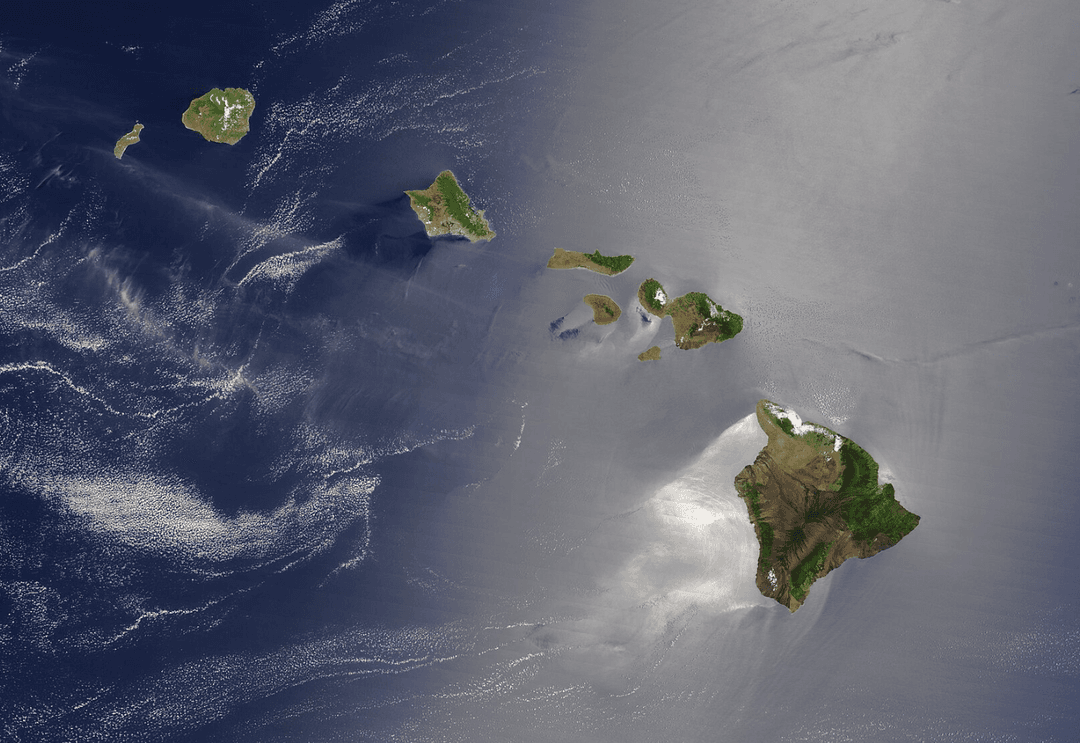
Formation of the Hawaiian Islands
Hawaiian volcanoes are shield volcanoes (stratovolcano) that experience growth, subsidence, and erosion.
While the volcano is on on the hotspot, it grows on layers of lava and ash. The slope from the summit to the shoreline average 7 degrees. Below the shoreline, the slope is even steeper because the water changes the viscosity and buoyancy of lava. This allows us to calculate the maximum heights reached during the growth phase.
Due to plate tectonics, the volcano eventually moves off the hotspot and begins to subside and erode. Subsidence is rapid and can be calculated as a function of mass. Erosion is the projected initial elevation minus post-subsidence elevation.
Price and Clague found that there have been few times when there has been tall volcanoes in close proximity, connected above the surface of the sea. Now is one of those times.
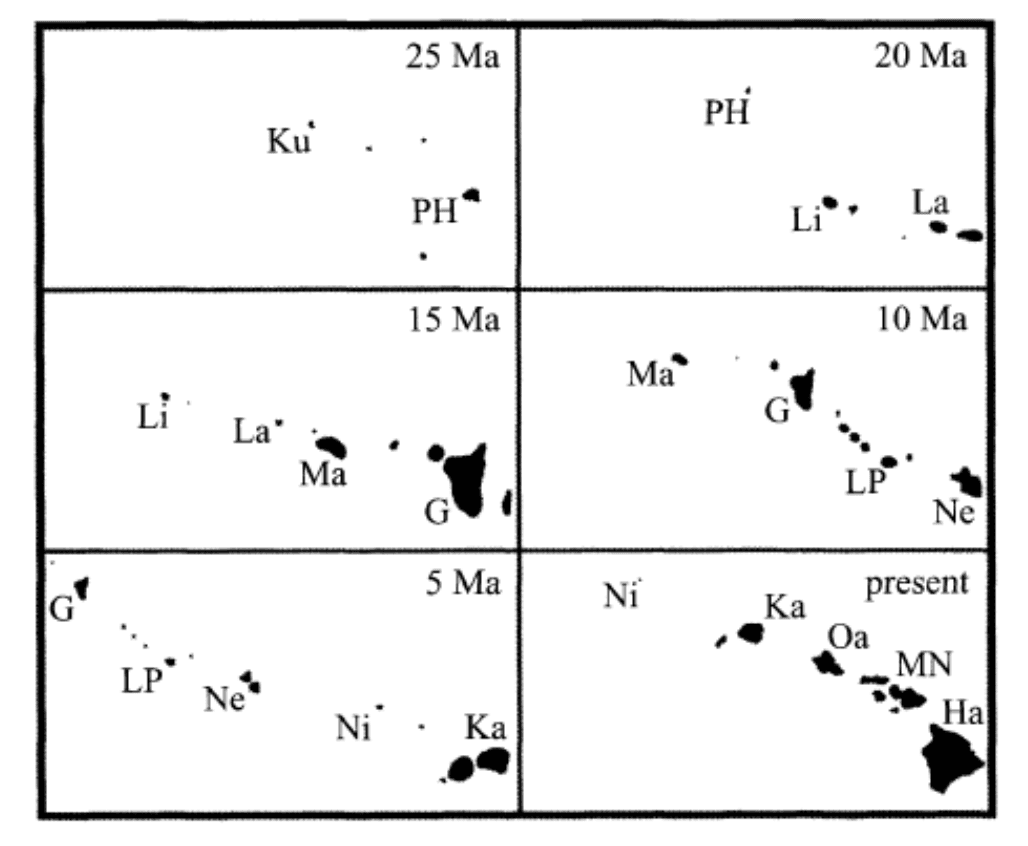
Adaptive Radiation
There are two ways speciation can occur:
- Allopatric speciation occurs as a result of isolation
- Sympatric speciation occurs in the same place
Adapative radiation is the rapid evolution of many species from a single ancestor when new ecological niches become available. It is caused by natural selection. It is important to note that adaptive radiation is not always allopatric or sympatric.
Convergent evolution is the independent evolution of similar features in species of different lineages. It occurs when species occupy similar environments and face similar selective pressures.
Endemism is the state of a species being unique to a geographic location, such as an island or country. Islands tend to have high levels of endemism due to isolation. e.g. Hawaiian honeycreepers and Darwin's finches
The Hawaiian honeycreepers are an example of adaptive radiation.
- Hawaii creeper and Kuai creeper is an example of convergent evolution. They share share bill shape, foraging behavior, and narrow notch-tipped tongue. The tongue evolved independently at least twice.
- Akiapola'au sucks saps and digs for larvae underneath the bark. The foraging behavior is convergent with sapsuckers. It only eats from 'Aki' trees, which tend to have smooth bark and produce more sap.
- I'iwi has a crimson plumage with salmon bill. Its long, curved bill is used for sipping nectar from flowers.
Question: Why does adaptive radiation seem to occur so often on islands?
Hypotheses:
- Islands lack predators that could prevent diversification
- Migration and then geographic isolation between islands could have caused allopatric speciation
Question: Four other passerine lineages colonized Hawaii. These populations lack the dramatic variation in bill morphology and plumage that characterize the honeycreeper radiation. Why does adaptive radiation occur in some lineages but not others?
Hypotheses (Lovette et al. 2001.):
-
Other species haven't had enough time to settle on the islands and diversify.
Using the molecular clock, we can estimate divergence times of Hawaiian honeycreepers and thrushes. We found that honeycreepers and thrushes colonized Hawaii around the same time. Thus, time alone cannot explain the difference in diversification.
-
Honeycreepers have an inherent propensity to respond to diversifying selection
We can compare morphological variation among the lineages from which honeycreepers and thrushes are derived. Morphological variation among honeycreepers is indeed quite great in comparison.
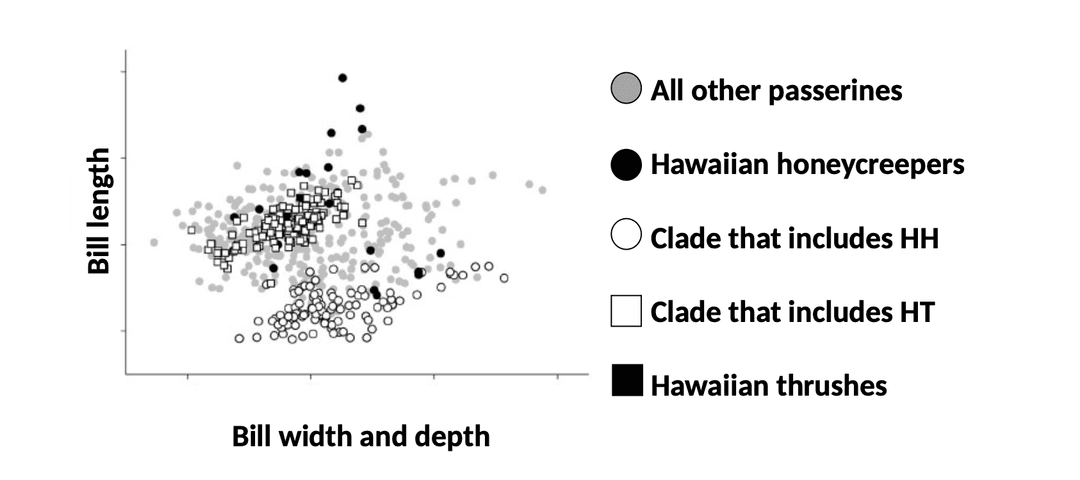
Lerner et al. (2011) noted that the Hawaiian islands only recently became tall and close-together. The height may have facilitated the formation of new ecological niches, while the proximity may have facilitated migration and gene flow between islands.
In the diagram below:
- Shaded bars are shield-building stages above water
- Lowercase letters indicate new lineages before and during Oahu (a, b), or before and during Maui Nui (c).

Non-Adaptive Radiation
Hawaiian land snails (Achatinella) are a great example of non-adaptive radiation.
Gulick (1872) made the following observations:
- Snails have very low mobility
- Genera are distributed among islands, and species are distributed within islands
- There are no environmental differences among populations
Thus, evolution must be driven by geographic isolation, not natural selection.
Conservation
Of the 41 species of Hawaiian land snails, 33 are extinct and 8 are endangered.
Hawaiian tree snail decline is caused by:
- Colonization by Polynesians (2 KYA)
- Arrival of Europeans and the brown rat
- Introduction of wolf snail as biological control for African giant snail
- Shell-collecting
- US Army bombing in Makua Valley
But conservation is a complex issue:
- Who decides what to conserve?
- Who decides how to conserve it?
Adaptive and Non-Adaptive Radiation
Hawaiian happy-face spiders are an example of both adaptive and non-adaptive radiation.
There are 16 species and 4 phenotypes:
- Green: leaf-dwelling, feeds on small insects
- Maroon: moss-dwelling, feeds on weakly-flying insects
- Large-brown: slow-moving, bark-dwelling, feeds on month and butterfly larvae
- Small-brown: twig-dwelling, feeds on very small flying insects
Communities of spiders on different islands are made up of different combinations of phenotypes. However, difference species of the same phenotype never live in the same community.
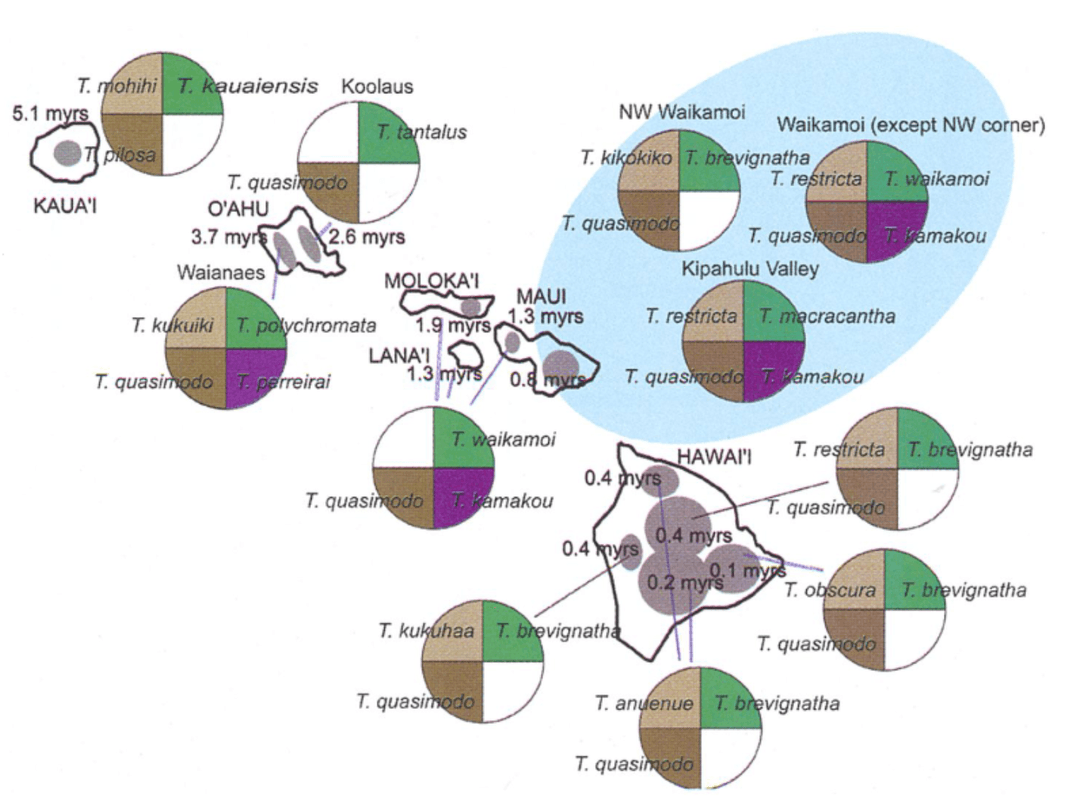
These phenotypes seem have at least evolved independently on different islands, suggesting adaptive radiation. However, the colonization of new islands did not always lead to the evolution of a new phenotype, which is evidence of non-adaptive evolution.
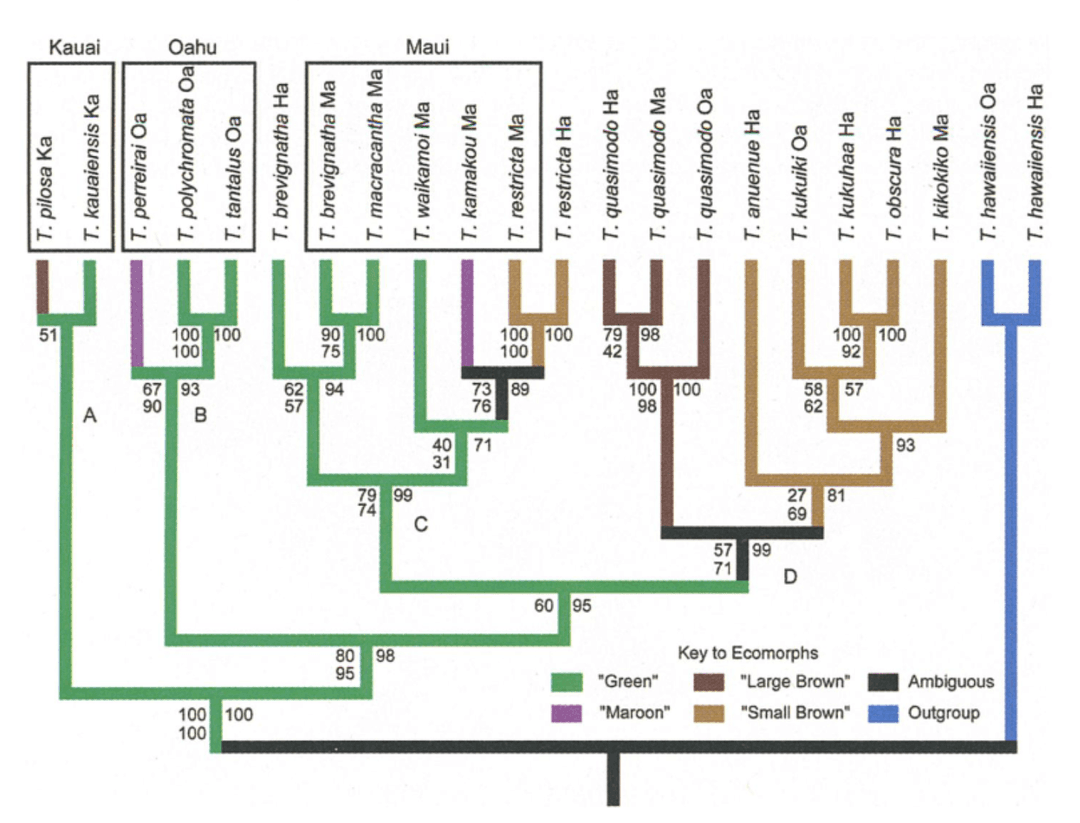
Ecogeographic rules
Allen's rule states that endothermic animals from colder climates have shorter limbs than similar animals from warmer climates.
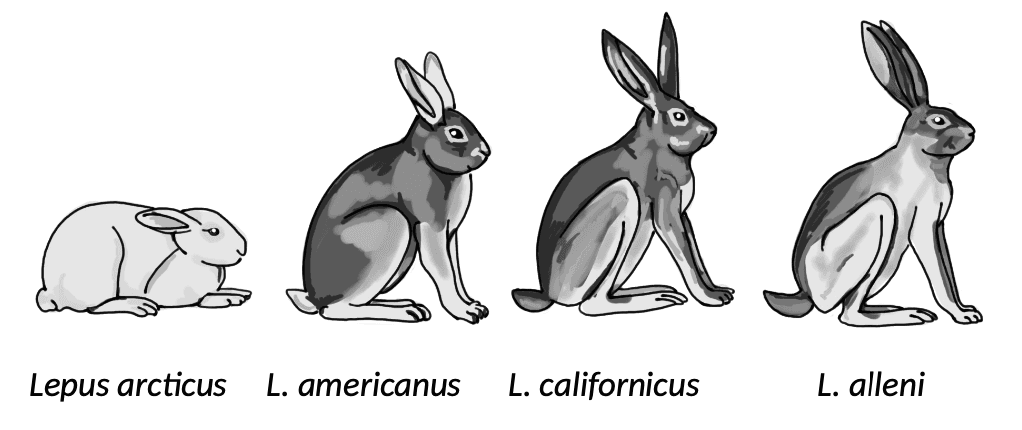
Bergmann's rule states that among broadly distributed endothermic animals, individuals of larger size are found near the poles. e.g. penguins.

Foster's rule states that species on islands tend to be smaller or larger than the mainland. e.g. tiny elephants in the Mediterranean.
Wallace's Line
The Wallace Line is a biogeographical boundary that separates the distinct fauna of Asia and Australia in the Malay Archipelago. For example, despite being widespread, tigers never crossed over the Malay peninsula. This line is real, but it's not a hard boundary. The transitional zone is called 'Wallacea.'

When it was colder, there were ice caps, and sea levels were lower. This exposed land bridges between Asia and Australia, allowing species to migrate. However, there were even deeper ocean trenches between Bali and Lombok, preventing migration.
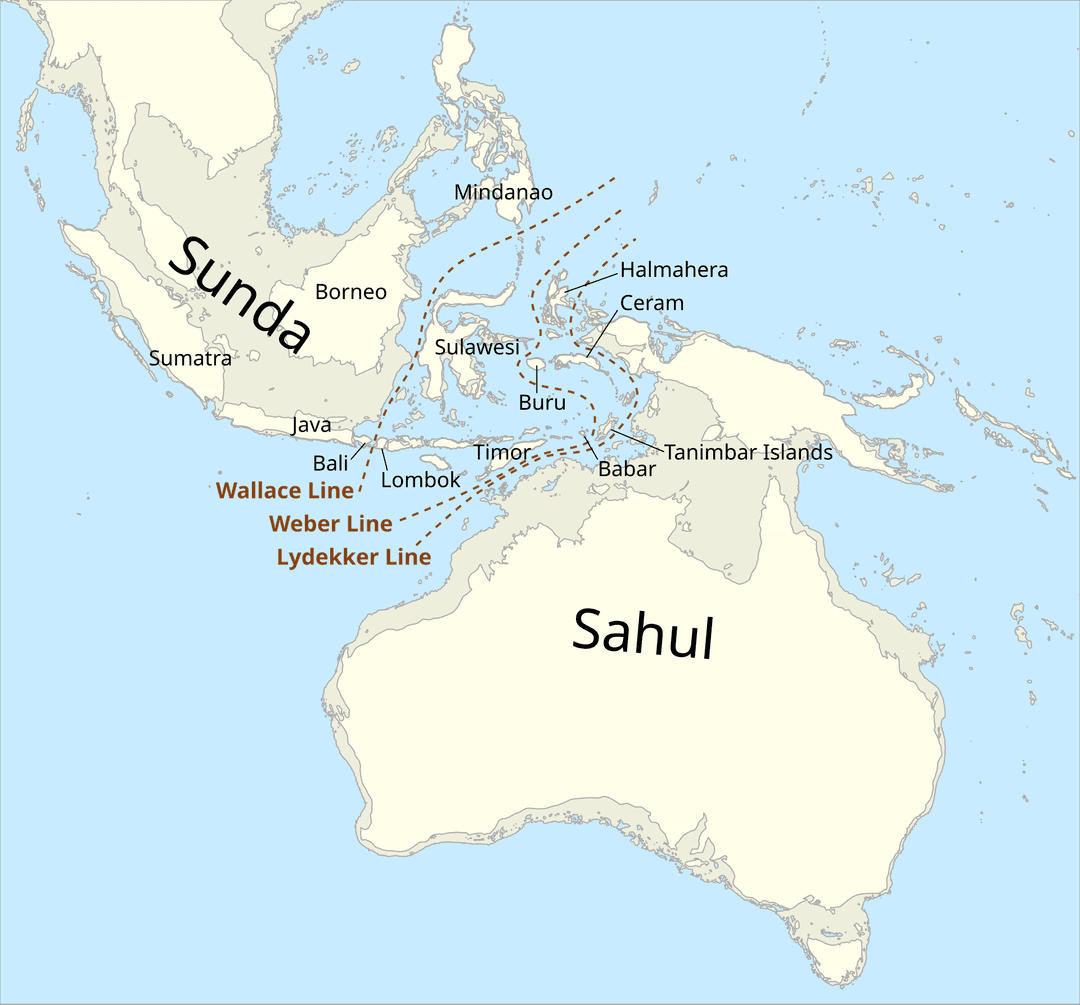
The taxonomic composition in Australia is very different from Asia.
- There were physical barriers to migration.
- There were different evolutionary histories; Asia was connected to Laurasia, while Australia was connected to Gondwana.
- Asia was connected to the continent, while Australia was more isolated.
On the Asia side, there were more:
- Placental mamals (primates)
- Species in general
On the Australia side, there were more:
- Marsupial mammals (kangaroos)
- Monotremes (platypus)
- Birds of paradise
Out-Of-India Hypothesis
The out-of-India hypothesis states that Asian taxa of Gondwanan origin arrived in Asia via India.
Dates:
- India and Madagascar split from Africa 160 MYA
- India and Madagascar split from Antarctica 130 MYA
- India and Madagascar split 90 MYA
- India was in isolation for 40 MY, and then collided with Asia 50 MYA
Problems with this hypothesis:
- Major climate and latitudinal changes 'should have' caused extinction
- K-T extinction 'should have' caused extinction
The out-of-Africa hypothesis is a competing hypothesis that Asian taxa of Gondwanan origin arrived in Asia from Africa by way of Eurasia. These hypotheses generate different predictions about divergence times:
- If it is of African origin, then a younger MRCA is possible
- If it is of Indian origin, then an older MRCA is possible

The Great American Interchange
Around 3 MYA, the Isthmus of Panama emerged
- Connected South America and North America
- Disconnected the Pacific and Atlantic oceans
- Created the Gulf Stream
Evidence:
- There is geological evidence that the Isthmas of the Panama lifted and the global sea level declined
- The divergence times of sister taxa on the tropical Pacific and the tropical Atlantic is always greater than 3 MYA
The Great American Interchange is the movement of animals between North and South America
- Camels, bears, elephants, cats, dogs, horses, and pigs moved south
- Anteaters, porcupines, opossums, sloths, and armadillos moved north
This interchange favored North American animals. Northern taxa were more likely to persist and diversity, while southern taxa were more likely to go extinct or not diversify. Southern fauna went extinct, while no northern fauna went extinct.
There are 2 hypotheses why:
- The south has less climate variability than the north due to being in the tropical climate zone
- The south was isolated, while the north was connected to Afro-Eurasia and already faced more competition
Sexual Selection
The birds of paradise (BOP) exhibit elaborate colors, sound, feathers, shape-shifting, and dance.

There are 5 main clades of BOP:
- Clade A includes manucodes and paradise crows. Females look like males and males help raise the young.
- Clade B includes King of Saxony BOP and parotias. King of Saxonies have eyebrow feathers, bright yellow plummage, and a loud call. Parotias are black birds with iridescent, structural coloration on their throats.
- Clade C includes twelve-wired BOP, sicklebills, standardwing, riflebirds, and astrapia.
- Clade D includes birds with long tail feathers, like the ribbon-tailed astrapia and Wilson's bird of paradise (sickletails).
- Clade E includes Paradisaea BOP, Wilson's BOP, magnificent BOP, and king BOP

Mating dances:
- Parotias create ground display courts where they dance for females. The display court preferably has horizontal branch for females to sit on and a canopy opening. Males will clean the court.
- Twelve-wired BOP dance on a vine, brushing the female with 12 'wires'
- Riflebirds dance on a vine, controlling the angle of observation to maximize the iridescence of their feathers. They also create noise with wing movement.
- Wilson's bird of paradise have intense pigmented colors in addition to iridescence, which modified coil-like feathers. They create display courts cleared of green elements. This is so that the females can better view the vibrant green on its chest.
- Greater BOP display in the canopy. They engage in lekking behavior, where a group of males displaying in the same location.
Evolution of traits:
- Black ovals have evolved multiple times with different mechanisms among riflebirds, parotia, long-tailed sicklebills, short-tailed sicklebills and the superb BOP.
- Shape-shifting, court display, and highly-modified feathers has also evolved multiple times.
- A few BOP are monogamous and lack sexual dimorphism. All others are polygamous and sexually dimorphic.

Question: The birds of paradise have sexually-selected traits that decrease survival. This seems to contradict the notion of evolution by natural selection.
There are actually multiple ways to increase fitness:
- Survival of offspring (traditional natural selection)
- Production of offspring (sexual selection)
Sexual selection is a case of natural selection where individuals achieve increased fitness by winning access to mates. This explains why the birds of paradise have traits that decrease survival but increase mating success.
Question: Why do females consider some males more attractive than others?
Selection works on males to produce honest, high-quality signals of 'good genes'. Selection works on females to find these signals attractive.
Peahens seem to select for size and quantity of eye spots. Petrie (1994) found that there is a correlation between chick weight and the size of the peacock's eyespots.
The red grouse has a reflective comb in red and ultraviolet. Mougeot et al. (2005) found that the comb is under sexual selection because UV reflectance is predictive of parasite burden.
The satin bowerbird creates a 'bower' display structure to impress females. Doucet and Montgomerie (2013) found that this demonstrates the bird's health and access to resources. It is also correlated with less parasites.
Question: How do birds learn to dance?
It is a mix of innate and learned. Juveniles will watch and practice for years.
Question: Why do females typically do the choosing?
There is a differential cost in mate choice. At the very least, the females need to grow the egg and lay the egg. There is also a limited amount of times she can reproduce over the course of her life. The male just needs to reproduce.paradise
e.g. In water bugs, the fertilized eggs are attached to the male's back, which he broods for up to one month. In this case, male selection is greater because they incur a higher cost.
References: